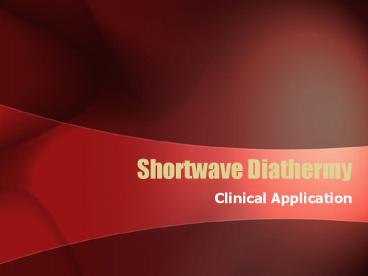Shortwave Diathermy - PowerPoint PPT Presentation
1 / 15
Title:
Shortwave Diathermy
Description:
To prevent burns cover the area with a dry terry cloth towel: ... Regularly check the skin for signs of burns and inquire about unusual sensations. ... – PowerPoint PPT presentation
Number of Views:5151
Avg rating:3.0/5.0
Title: Shortwave Diathermy
1
Shortwave Diathermy
- Clinical Application
2
Treatment Dosages
- Pulse
- Dose Sensation Width Rate (pps)
- NT No warmth 65 µsec 100 200
- 1 Mild warmth 100 µsec 800
- 2 Moderate warmth 200 µsec 800
- 3 Vigorous warmth 400 µsec 800
3
Pulsed SWD Setup
- Parameter Setting
- Output mode Pulsed
- Bursts per sec 800
- Burst duration 400 sec
- Interburst 850 secinterval
- Output intensity 150 W RMS
- 48 W/burst RMS
- RMS Root Mean Squared
4
Set-up and Application
5
Treatment Duration
- Nonthermal, Mild, and Moderate Heating
- Duration 20 to 30 minutes
- Repeated as needed
- Two weeks
- Vigorous Heating
- Duration 15 minutes
- Applied every other day
6
Precautions
- Remove contact lenses when applying SWD around
the head, face, or eyes. - Cover the skin with at least 0.5 inch of toweling
- Do not allow perspiration to collect in the
treatment field. - Thick adipose tissue in the treatment area can
result in overheating. - Never allow the skin to come into contact with
the heating unit or cables. - If the cable method is used, do not allow them to
touch each other. - If electrode pads are used, space them at least
the distance of their diameter apart. - A deep, aching sensation may be a symptom of
overheating the tissues. - Overheating of the patients tissues may cause
tissue damage without any immediate signs. - The SWD energy scatters 2 to 3 feet from the
source - A distance of 3 feet from the source of the
energy should be maintained to ensure the
operators safety.
7
Instrumentation
- Master Power Switch Turns the unit on.
- Output Intensity (Power) Adjusts the amount of
energy delivered to the patient. - Patient Interrupt Switch (Safety Switch) Allows
the patient to end the treatment. - Pause Interrupts the treatment to allow
repositioning of the patient, etc.
8
Instrumentation (Cont.)
- Pulse Rate (Pulse Frequency) Sets the number of
pulses per second (PPS) for the output. - Start/Stop Initiates or terminates the
treatment. - Treatment Timer Sets the treatment duration.
- Tuning Adjusts the output resonance to match the
patients tissues. - Some units will shut off if an out of tune state
is detected - Most contemporary units are self-tuning
9
Patient Preparation
- Ensure the absence of all contraindications.
- Remove all jewelry, clothing, coins, and other
metallic items from the patient. - For personal safety, remove your rings, watches,
bracelets, etc. - No metal can be within the immediate treatment
area - Keep the patient out of reach of any metal
objects that can serve as a ground (e.g.,
outlets, pipes). - Clean and dry the body part. Water, skin oils,
etc. can increase superficial heat production.
10
Patient Preparation (Cont.)
- Position the patient in the most appropriate
manner for the body area being treated. - To encourage venous return, elevate the treated
extremity. - To prevent burns cover the area with a dry terry
cloth towel - This provides spacing between the source of the
shortwave diathermy - Absorbs perspiration
- A portion of the treatment area must remain
visible to check for burns during the treatment.. - Explain to the patient that mild warmth should be
felt. - Instruct the patient to inform you if any unusual
sensations are experienced.
11
Patient/Generator Tuning
- If the unit must be manually tuned
- Position the electrodes over the patient.
- Increase the output intensity to appx. 40 of the
max. - Adjust the TUNING control until the output meter
reaches its peak - then decrease the TUNING to the patients
comfort. - A unit is tuned when less than half of the
maximum output is used. - Some units will automatically shut off if more
than 50 percent of the maximum output is used.
If this occurs, the unit must be tuned again.
12
Initiation of the Treatment
- Drum Method
- Turn the unit on allow it to warm up if
necessary. - Some units must be tuned to allow for maximal
energy transfer. - If indicated by the manufacturers instructions,
place a folded towel between the body part and
the drum. - Position the drum approximately 0.5 to 1 in.
above the toweling. - The surface of the drum must be parallel to the
skin surface being treated, otherwise the skin
closest to the drum will overheat (the Cosine Law)
13
Initiation of the Treatment (Cont.)
- Instruct the patient not to move until the unit
is shut off. - Set the TIMER to the desired treatment duration.
- Increase the intensity until the patient feels
mild warmth. - If the drum must be moved or if it becomes
necessary to dry the area, return the intensity
to zero before making any adjustments. - Do not leave the patient left unattended
- Regularly check the skin for signs of burns and
inquire about unusual sensations. - Adjust the INTENSITY, PULSE RATE, and/or
electrode placement as necessary.
14
Termination of the Treatment
- After the treatment, return the intensity to
zero and shut off the unit. - Inspect the skin for signs of burns or other
abnormal treatment outcomes. - Record the treatment parameters in the patients
file.
15
Maintenance
- Daily Maintenance
- Clean the face of the drum or cables using a
manufacturer-approved cleanser. - Regular Maintenance
- Inspect electrical cords for kinks and frays.
- Annually
- The unit must be serviced and calibrated by a
qualified service technician.

